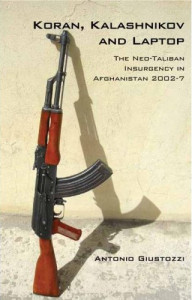|
Reviewed by Mark T. Clark, Ph.D., Professor of Political Science, Director of the National Security Studies program, California State University, San Bernardino, Director of the CSU Intelligence Community Center of Academic Excellence The famous military theoretician, Carl von Clausewitz, remarked that war is never final. “The defeated … often considers the outcome merely as a transitory evil, for which a remedy may still be found in political conditions at some later date.” Soon after its rapid defeat in the Fall of 2001, many of the Taliban fled to Pakistan while others melted back into the population. However, defeat and demoralization did not stop them all. Very soon, many of them began organizing for a return to power. Giustozzi’s work traces the emergence of the new Taliban and its growth into a full-scale—and effective—insurgency. The author captures only a small, but useful, difference between the old from the new Taliban in the title of his work: where the old Taliban leadership clumsily relied on a rigid and doctrinaire interpretation of the Koran and an unskilled use of rifles, the new Taliban has adopted flexibility in implementing strict interpretations of Sharia law, when it suits their purposes, but more importantly, has embraced new strategies and technologies—including computers—to make their efforts succeed. Probably the greatest successes of the neo-Taliban have been a function of three things. First, the leadership of the neo-Taliban exploited the political weaknesses of the new government of Afghanistan, especially in the relationship between the central and local governments. Second, the neo-Taliban willingly adopted new strategies and tactics in fighting whatever amounted to the Afghan army, its militias, and its “foreign” supporters. And third, they confronted an inconsistent and ineffective counter-insurgency strategy against them, one that changed almost every six months for the last several years. Giustozzi’s work is at its best when he traces the details of the neo-Taliban’s development. In six chapters, he shows the reader how the neo-Taliban reorganized, recruited, developed its political strategies and military tactics, and adapted to the changing political conditions of Afghanistan over the course of the period from 2002 to about mid-2007. He takes the reader as far as the evidence, which can be murky at best when covering an insurgency from the outside, can take him. But he also lets the reader see where evidence no longer exists, where opinion and speculation take over, and he offers differing opinions, including his, as to where further evidence may lead. The picture he paints is of a very complicated, patchwork country of different loyalties, ethnicities, and levels of political competence and corruption which a dedicated and ruthless opponent has learned to exploit. Where his work is at its weakest, however, is in his attempt to explain the neo-Taliban strategy in terms familiar to readers of strategy. He compares three possible “strategies” or schools of thought on the neo-Taliban strategy: Fourth Generation Warfare, Maoist guerrilla warfare, and the “War of the Flea,” based on the strategy adopted by the Afghan mujahideen of the 1980’s. Giustozzi prefers the ideas of Fourth Generation Warfare over what Special Operations officers in Afghanistan describe as a modified Maoist guerrilla warfare, believing that the latter only read into the neo-Taliban strategy what they learned at Fort Bragg. There are at least two problems with this interpretation. First, Fourth Generation Warfare, whatever its merits, is only a school of thought, an interpretation of the history of warfare and the dominant modes of fighting in different epochs. It is not a strategy. Maoist guerrilla warfare, on the other hand, is a strategy for insurgency, a theory for a peasant-based guerrilla army to gain and control a country. And second, while he argues that it is unlikely any of the neo-Taliban leadership would have read Mao’s writings on guerrilla warfare, he also notes that the neo-Taliban got its start and initial help from elements of Pakistan’s army and intelligence services. Surely, as one of China’s closest allies in many respects, these supporters would have had at least a rudimentary—if not clear—understanding of Mao’s ideas. More importantly, however, the neo-Taliban’s clear and consistent emphasis on the political strategy of its insurgency mimics Mao’s emphasis on the political. After all, Mao followed Clausewitz closely and gave special importance to achieving political objectives over tactical successes. Nonetheless, Giustozzi—who is based at the Crisis States Research Centre at the London School of Economics and has researched and written on Afghanistan for over ten years—has done a fine job in reporting the growing insurgency of the neo-Taliban in Afghanistan. For those interested in understanding the increasing problems in Afghanistan, or for testing their favorite theories on strategy, this work is invaluable. |


 Koran, Kalashnikov, and Laptop: The Neo-Taliban Insurgency in Afghanistan
Koran, Kalashnikov, and Laptop: The Neo-Taliban Insurgency in Afghanistan